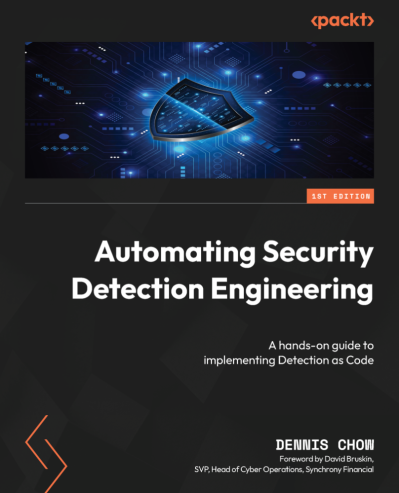Most Commented
Automating Security Detection Engineering: A hands-on guide to implementing Detect...




Description material

epub | 22.91 MB | English | Isbn:9781837631421 | Author: Dennis Chow, David Bruskin (Foreword by) | Year: 2024
About ebook: Automating Security Detection Engineering: A hands-on guide to implementing Detection as Code
Accelerate security detection development with AI-enabled technical solutions using threat-informed defense
Key Features
Create automated CI/CD pipelines for testing and implementing threat detection use cases
Apply implementation strategies to optimize the adoption of automated work streams
Use a variety of enterprise-grade tools and APIs to bolster your detection program
Purchase of the print or Kindle book includes a free PDF eBook
Book Description
Today's global enterprise security programs grapple with constantly evolving threats. Even though the industry has released abundant security tools, most of which are equipped with APIs for integrations, they lack a rapid detection development work stream. This book arms you with the skills you need to automate the development, testing, and monitoring of detection-based use cases. You'll start with the technical architecture, exploring where automation is conducive throughout the detection use case lifecycle. With the help of hands-on labs, you'll learn how to utilize threat-informed defense artifacts and then progress to creating advanced AI-powered CI/CD pipelines to bolster your Detection as Code practices. Along the way, you'll develop custom code for EDRs, WAFs, SIEMs, CSPMs, RASPs, and NIDS. The book will also guide you in developing KPIs for program monitoring and cover collaboration mechanisms to operate the team with DevSecOps principles. Finally, you'll be able to customize a Detection as Code program that fits your organization's needs. By the end of the book, you'll have gained the expertise to automate nearly the entire use case development lifecycle for any enterprise.
What you will learn
Understand the architecture of Detection as Code implementations
Develop custom test functions using Python and Terraform
Leverage common tools like GitHub and Python 3.x to create detection-focused CI/CD pipelines
Integrate cutting-edge technology and operational patterns to further refine program efficacy
Apply monitoring techniques to continuously assess use case health
Create, structure, and commit detections to a code repository
Who this book is for
This book is for security engineers and analysts responsible for the day-to-day tasks of developing and implementing new detections at scale. If you're working with existing programs focused on threat detection, you'll also find this book helpful. Prior knowledge of DevSecOps, hands-on experience with any programming or scripting languages, and familiarity with common security practices and tools are recommended for an optimal learning experience.
Key Features
Book Description
Today's global enterprise security programs grapple with constantly evolving threats. Even though the industry has released abundant security tools, most of which are equipped with APIs for integrations, they lack a rapid detection development work stream. This book arms you with the skills you need to automate the development, testing, and monitoring of detection-based use cases. You'll start with the technical architecture, exploring where automation is conducive throughout the detection use case lifecycle. With the help of hands-on labs, you'll learn how to utilize threat-informed defense artifacts and then progress to creating advanced AI-powered CI/CD pipelines to bolster your Detection as Code practices. Along the way, you'll develop custom code for EDRs, WAFs, SIEMs, CSPMs, RASPs, and NIDS. The book will also guide you in developing KPIs for program monitoring and cover collaboration mechanisms to operate the team with DevSecOps principles. Finally, you'll be able to customize a Detection as Code program that fits your organization's needs. By the end of the book, you'll have gained the expertise to automate nearly the entire use case development lifecycle for any enterprise.
What you will learn
Who this book is for
This book is for security engineers and analysts responsible for the day-to-day tasks of developing and implementing new detections at scale. If you're working with existing programs focused on threat detection, you'll also find this book helpful. Prior knowledge of DevSecOps, hands-on experience with any programming or scripting languages, and familiarity with common security practices and tools are recommended for an optimal learning experience.
Warning! You are not allowed to view this text.
Warning! You are not allowed to view this text.
Join to our telegram Group
Information
Users of Guests are not allowed to comment this publication.
Users of Guests are not allowed to comment this publication.
Choose Site Language
Recommended news
Commented



![eM Client Pro 9.2.1735 Multilingual [Updated]](https://pikky.net/medium/wXgc.png)






![Movavi Video Editor 24.0.2.0 Multilingual [ Updated]](https://pikky.net/medium/qhrc.png)

